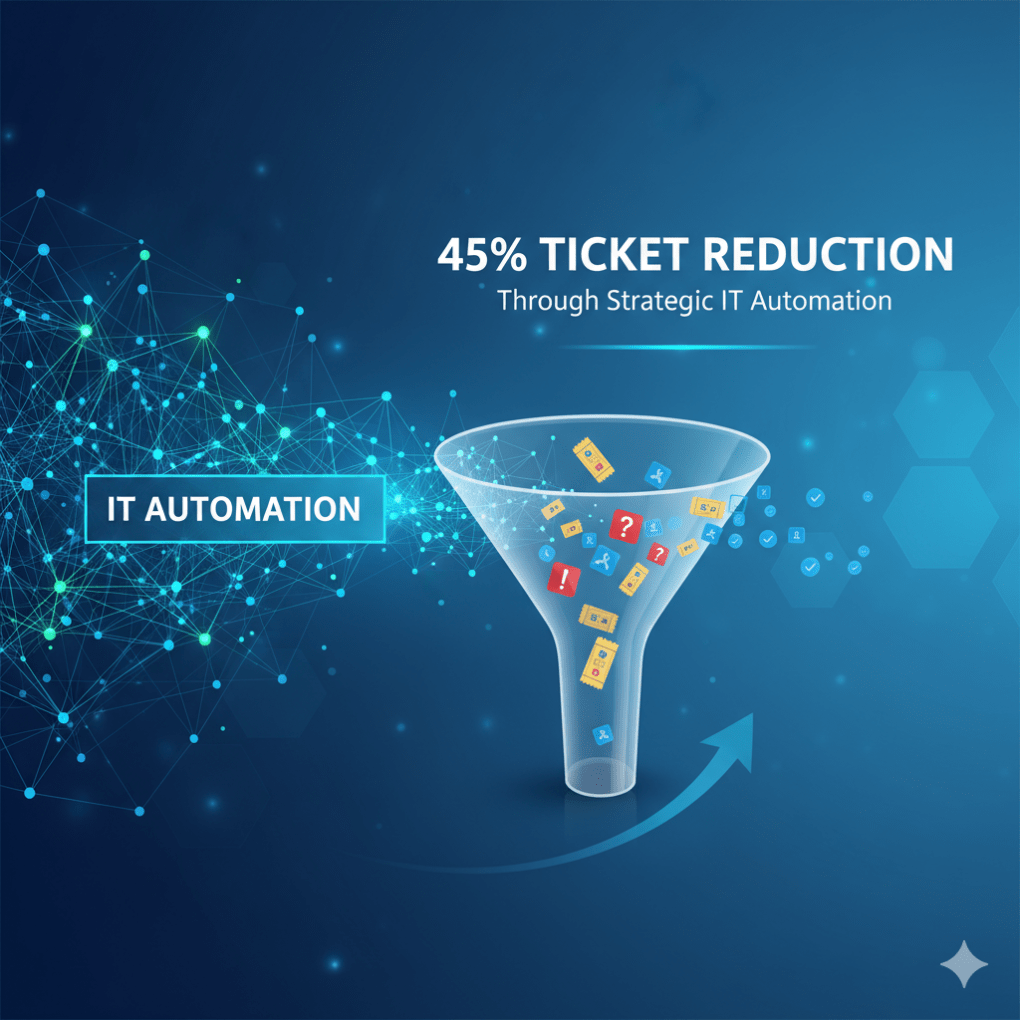Contents
Overview
Managing IT operations across large consumer goods enterprises demands efficiency, reliability, and compliance.
This case study explores how a leading consumer goods organization implemented an intelligent IT automation platform to streamline operations, reduce manual intervention, and achieve a 45% reduction in IT support tickets.
By orchestrating automation across users, IT teams, and leadership systems, the enterprise improved device health, enhanced compliance posture, and aligned IT service delivery with core business goals.
The Challenge: Fragmented Systems and Growing IT Complexity
As the organization scaled, its IT landscape became increasingly fragmented. Multiple tools managed endpoints, compliance checks, and user support—each operating in silos.
This resulted in:
-
High volumes of repetitive support tickets
-
Delayed issue resolution
-
Limited visibility into device compliance and performance
-
Reduced employee productivity
IT leadership needed a scalable IT automation solution capable of:
-
Integrating with existing ITSM and monitoring tools
-
Automating endpoint maintenance and compliance management
-
Providing proactive insights and user engagement
-
Delivering unified visibility to IT administrators and CIOs
The Solution: Unified IT Automation and Orchestration Platform
To overcome these challenges, the enterprise deployed a smart IT automation and orchestration platform that unified people, processes, and technology.
1. Proactive Endpoint Automation
The platform executed background tasks such as disk cleanup, performance tuning, and patch verification—preventing common system issues before they triggered support tickets.
2. AI-Powered User Engagement
Employees received real-time device health and compliance scores with AI-based recommendations for self-healing actions like password resets and system updates.
3. Continuous Compliance Monitoring
The platform enforced compliance controls by tracking encryption, antivirus status, drive utilization, and cookie hygiene—ensuring continuous audit readiness.
4. Smart ITSM Integration
When critical events occurred, the system generated prioritized tickets in the existing IT Service Management (ITSM) platform, improving SLA adherence and response time.
5. Remote Remediation Capabilities
IT administrators could perform backend fixes remotely or involve users only when necessary, reducing downtime and operational friction.
6. Rapid Automation Bot Development
Using a no-code/low-code authoring tool, IT teams created automation bots in hours—accelerating digital transformation initiatives significantly faster than traditional scripting.
Results: Measurable IT and Business Impact
| Outcome | Impact |
|---|---|
| Support ticket reduction | 45% fewer support tickets |
| Operational efficiency | Reduced support costs and overhead |
| Employee productivity | Improved uptime and faster resolutions |
| Compliance and security | Stronger preventive monitoring and control |
| IT agility | Faster deployment of automation workflows |
Strategic Impact for IT Leadership
1. Cost Optimization
Reduced ticket volumes directly translated into lower support costs and freed up IT resources for innovation-driven initiatives.
2. User Empowerment and Experience
Proactive insights and self-service tools enhanced employee experience and reduced downtime.
3. Risk Mitigation
Continuous compliance monitoring enabled early detection of security and policy violations.
4. Business Alignment
Automation helped IT operations align more closely with organizational goals, making IT a strategic partner rather than a reactive support function.
Conclusion: Transforming IT from Reactive to Strategic
This case study demonstrates how intelligent IT automation platforms can transform large enterprise IT environments from reactive, ticket-driven models into proactive, value-driven ecosystems.
By connecting users, IT admins, and leadership through automation and AI insights, enterprises can:
-
Reduce IT workloads
-
Improve device health and compliance
-
Strengthen business continuity
-
Enable IT to drive measurable business outcomes

